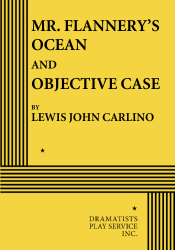THE STORIES: Mr. Flannery's Ocean. Jim Flannery, seventy-nine, retired seaman, belligerent, cantankerous and very human, has laid claim to an ocean. On the terrace of an old weather-beaten resort hotel on the southern coast of England he sits in his deck chair, ever watchful, ever ready to defend his right to ownership, an ownership which grew simply out of a need to belong to and protect something. Flannery is absolutely convinced he owns this body of water and, surprisingly enough, is successful in intimidating everyone else around him into treating him correspondingly, everyone that is, except Maug, the cockney maid who can never seem to bring Flannery's tea hot enough. These two spend their days in perpetual combat. To the hotel comes an American, Mrs. Pringle, widowed and childless, to spend her wheelchair days in the hope of getting some health from the sea breezes. Mrs. Pringle is a woman with a wistful sadness in her eyes; a look of surrender and reconciliation to long hours of sickness and the despair of being completely alone. How and why Jim Flannery gives this woman his ocean, his only and most prized possession, is the story of the play. It is the magical tale of the giving and the receiving of a gift which no one believed could be possessed. (2 men, 4 women, 1 boy, 1 girl.)
Objective Case. This is a play that vacillates on a thin line between expressionism and realism. Essentially, it is a story of a man and woman desperately and pathetically in love. Each of these two people has a defect. He likes to pull his ear and scratch his teeth. She likes to blink her eyes and droop her lip. These defects become the symbol of each other's human imperfection and, tragically, also the focal point for each other's ambivalent feelings of hate. The entire play builds to a love scene in which, still cursed by their inability to bare themselves, he and she take refuge behind mannequins. The love scene begins and goes along well enough for a while, both of them expressing their affections from behind the refuge of their inanimate counterparts. Then, each sees the other's defect, and the scene explodes in chaos. He and she scream hate at each other as they run off the stage. A moment of silence passes. Then, the mannequins continue the love scene. They introduce themselves as Him and Her, the objective case of He and She. The mannequins fall in love. Strangely enough, the focus of this is are the imperfections that generated hate in their human counterparts. (2 men, 2 women.)
